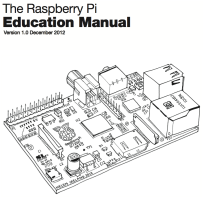Educational manual for Raspberry Pi released

![]() The cover of the Raspberry Pi Education Manual
The cover of the Raspberry Pi Education Manual
Created by a team of teachers from Computing at School, the newly published Raspberry Pi Education Manual� ![]() sets out to provide support for teachers and educators who want to use the Raspberry Pi in a teaching environment. As education has been part of the original Raspberry Pi Foundation's mission, the foundation has supported the development of the manual.
sets out to provide support for teachers and educators who want to use the Raspberry Pi in a teaching environment. As education has been part of the original Raspberry Pi Foundation's mission, the foundation has supported the development of the manual.
The manual has chapters on the basics of Scratch, experiments with Python, connecting programs with Twitter and other web services, connecting up the GPIO pins to control devices, and using the Linux command line. Two chapters, one on Greenfoot and GeoGebra, are not currently included in the manual as both applications require a Java virtual machine which is currently being optimised for the Pi platform.
The Scratch section, for example, explains how to work with the graphical programming environment and use sprites, first to animate a cat, then make a man walk, and then animate a bee pollinating flowers. It then changes gear to show how to use Scratch for solving maths problems using variables, creating an "artificial intelligence", driving a robot, making a car follow a line, and animating a level crossing, and wraps up with a section on creating games.
The manual is available as a PDF which can be downloaded directly or obtained from the Raspberry Pi Store. It is licensed under a Creative Commons-Attribution-NonCommercial-ShareAlike 3.0 licence. Note that this is not an open source licence as defined the OSI as it prohibits commercial use; the definition of "commercial" is also vague, though the Raspberry Pi Foundation blog entry interprets it as "you just can’t sell it".
See also:
- Eben Upton: An educational life of Pi, an interview with the Raspberry Pi founder on
(djwm)
![Kernel Log: Coming in 3.10 (Part 3) [--] Infrastructure](/imgs/43/1/0/4/2/6/7/2/comingin310_4_kicker-4977194bfb0de0d7.png)

![Kernel Log: Coming in 3.10 (Part 3) [--] Infrastructure](/imgs/43/1/0/4/2/3/2/3/comingin310_3_kicker-151cd7b9e9660f05.png)
















